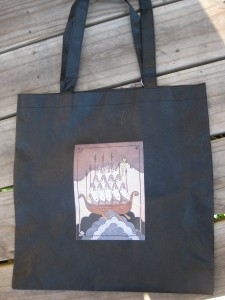I was tagged by Julianne Douglas over on Facebook to quickly write down ten books that have meant something to me, and then pass along the request to ten more people. I can’t do anything the easy way, so I thought it would be fun to do a blog post about it, and to explain why these books are important to me. Since it is the time of year when many people are looking for gift ideas, maybe even some of what I say will provide some inspiration. I am going to stick close to historical fiction for my list, since I have been thinking a lot recently about what makes good historical fiction in general, and medieval historical fiction in particular.
- Sigrid Undset, Kristin Lavransdattir. It is maybe cheating to begin with this because I have about fifty more pages to go, but it was reading this book that got me thinking about medieval historical fiction in the first place. Somehow Undset managed to write here a novel that continues to speak immediately to contemporary themes and problems, while at the same time maintaining a perfect period voice. I have not discovered one jarring note (though specialists in medieval Scandinavia might feel differently). I am thinking of how I could work it into a course.
- Cecelia Holland, Great Maria. This novel is another of the first that comes to mind when I think of other books I have loved that, for me, capture the Middle Ages and its values perfectly. Its heroine is awkward and difficult, and unsympathetic at times. This is because she thinks and feels and acts differently than we would do. This is because she lives in a very different world, and Holland does not allow us to forget it.
- Margaret Elphinstone, The Sea Road. This one will be less well known even to my book-reading and medievalist friends. It is the eleventh-century tale of Gudrid, as told to a cleric and scribe in Rome, of her role in the Viking exploration of the North Atlantic and her own journey to North America. Gudrid’s world is pagan and Christian, civilized and wild and once again, Elphinstone gets her voice perfectly. I should also say that everything Elphinstone writes is an instant hard-cover buy for me.
- J.R.R. Tolkien, The Lord of the Rings. This isn’t historical fiction, most would argue, but rather fantasy. I am going to argue that it belongs on this list of books that made me think about how to write historical fiction. Tolkien’s Middle Earth is not some fantasy realm in some imaginary world, however it may appear to a casual reader. He binds it to the geography and language of the word that we know, the world that is ours, by creating stories told about stories told about stories, layering the past upon the past.
- Carlos Ruiz Zafon, Shadow of the Wind. I saw that Julianne had The Angel’s Game on her list which I unaccountably still have not read, though I went to an author reading when it first came out, and got a signed copy. This one is a book about books by a man who loves books. More than that, Ruiz Zafon casts a spell on the reader from the very first page. We are in post-civil war Barcelona with all its beauty, menace, and danger until the last page when he lets us go again.
- Susanna Clarke, Jonathan Strange and Mr. Norrell. This is the perfect book for someone raised on Georgette Heyer and Jane Austen. Like Heyer, she captures that Regency voice without anachronism, and at the same time manages to work in the magic in a way that seems seamless and plausible.
- Hilary Mantel, Wolf Hall. Hilary Mantel in her best historical fiction, here and in A Place of Greater Safety, about the French Revolution not only writes a historical novel, but constructs a historical argument. Here, her argument is a revisionist portrait of Thomas Cromwell. Usually he is depicted as the most hated of Henry VIIIs servants, but Mantel gives us a view of him from the inside to present him as a more sympathetic character. Her depiction of Thomas Wolsey and Thomas More were equally daring.
- Sarah Dunant, Sacred Hearts. Most people would think that a story that takes place entirely within the walls of a tightly enclosed sixtenth-century Ferarrese convent would not be interesting. Those people would be wrong. I read this shortly after teaching a class on Terese of Avila’s autobiography and felt it gave flesh to some of the bones of what Teresa describes.
- Markus Zusak, The Book Thief. I have already discussed this book on my blog, so I won’t say too much here except that this is another book about books (I am detecting a theme here…), and it made me have sympathy for characters I thought I could not feel sympathy for.
- Simon Mawer, The Glass Room. The story of the twentieth-century told through a modernist house built in what was once Czechoslovakia, this one hits close to home. Not only does it depict the world of my ancestors, the world into which my father was born, and the pain of going into exile from that world, the characters themselves reflect elements of members of my family. This may, then, seem less strictly “historical” than the other works on my list. But whether a book takes us to Tang China or Renaissance Italy, surely we love it because we see parts of ourself in it?

